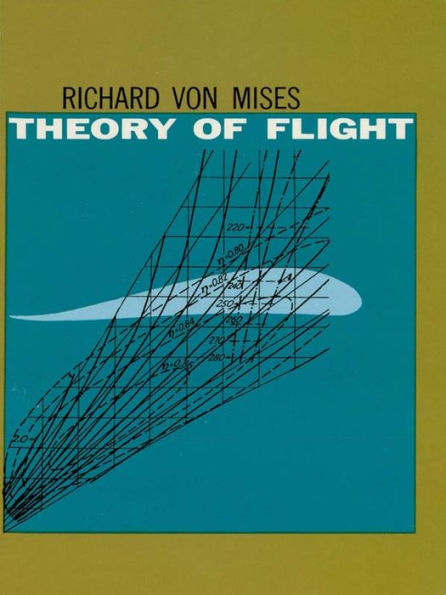

eBook
Related collections and offers
Overview
"An outstanding textbook." — Scientific, Medical and Technical Books
Almost unsurpassed as a balanced, well-written account of fundamental fluid dynamics, Theory of Flight may still be recommended for a clearer presentation than is to be forced in many more recent works, though it is limited to situations in which air compressibility effects are unimportant.
Designed for the college senior or beginning graduate student, the text assumes a knowledge of the principles of calculus and some training in general mechanics. It is unusual in offering a well-balanced introduction, stressing equally theory and practice. It avoids the formidable mathematical structure of fluid dynamics, while conveying by often unorthodox methods a full understanding of the physical phenomena and mathematical concepts of aeronautical engineering. Theory of Flight contains perhaps the best introduction to the general theory of stability, while the introduction to dynamics of incompressible fluids and the chapters on wing theory remain particularly valuable for their clarity of exposition and originality of thought.
Mises' position as one of the great pioneers in the development of the aeronautical sciences lends a flavor of authenticity not found in more conventional textbooks. Any student who has made himself familiar with his exposition of the fundamentals and applications will have acquired an excellent background for additional, more specialized fields of modern aeronautical engineering.

Product Details
| ISBN-13: | 9780486132228 |
|---|---|
| Publisher: | Dover Publications |
| Publication date: | 03/30/2012 |
| Series: | Dover Books on Aeronautical Engineering |
| Sold by: | Barnes & Noble |
| Format: | eBook |
| Pages: | 672 |
| File size: | 42 MB |
| Note: | This product may take a few minutes to download. |
Table of Contents
PrefacePart One
EQUILIBRIUM AND STEADY FLOW IN THE ATMOSPHERE
CHAPTER I. THE ATMOSPHERE AT REST
1. Density. Pressure. Equation of State
2. Equilibrium of a Perfect Gas under the Influence of Gravity
3. The Standard Atmosphere
4. Determination of True Altitude. Reduction of a Climb to Standard Atmosphere
5. Troposphere and Stratosphere. Influence of Humidity
CHAPTER II. BERNOULLI'S EQUATION. ROTATION AND CIRCULATION
1. Steady Motion
2. Bernoulli's Equation
3. Dynamic Pressure
4. Variation of Total Head across the Streamlines. Rotation
5. Circulation and Rotation
6. The Bicirculating Motion
CHAPTER III. MOMENTUM AND ENERGY EQUATIONS
1. Flux of Momentum in Steady Flow
2. Momentum Equation for Steady Flow
3. Moment of Momentum
4. Quasi-steady Flow. Relative Flow
5. Energy Equation
CHAPTER IV. PERFECT AND VISCOUS FLUIDS. TYPES OF FLOW
1. Viscosity
2. Law of Similtude. Reynolds Number
3. Laminar and Turbulent Motion
4. Continuous and Discontinuous Motion
5. Boundary Layer
"CHAPTER V. AIR RESISTANCE, OR PARASITE DRAG"
1. Definitions
2. Bluff Bodies
3. Round Bodies
4. Streamlined Bodies
5. Skin Friction
6. Parasite Drag of Major Airplane Components
Part Two
THE AIRPLANE WING
CHAPTER VI. FUNDAMENTAL NOTIONS. GEOMETRY OF WINGS
1. The Three Coefficients
2. Geometry of Airfoil Profiles. Sets of Profiles
3. Theoretically Developed Airfoil Sections
4. Geometry of Airplane Wings
CHAPTER VII. EMPIRICAL AIRFOIL DATA
1. The Three Main Results
2. Influence of Aspect Ratio
3. Historical Development of wing Profiles
4. Influence of the Shape of the Profile
5. Influence of the Reynolds Number. Degree of Turbulence
CHAPTER VIII. THE WING OF INFINITE SPAN
1. The Momentum Equation for Irrotational Flow
2. The Lift on an Airfoil of Infinite Span
3. The Pitching Moment of an Airfoil on Infinite Span
4. The Metacentric Parabola
5. "Vortex Sheets, Another Approach"
6. Theory of Thin Airfoils
CHAPTER IX. THE WING OF FINITE SPAN
1. Curved Vortex Lines
2. Vortex Sheet and Discontinuity Surface
3. The Flow Past a Wing of Finite Span
4. Prandtl's Wing Theory
5. Elliptic Lift Distribution
6. Biplane Theory
7. General Lift Distribution
CHAPTER X. ADDITIONAL FACTS ABOUT WINGS
1. Stalling
2. High-lift Devices
3. Pressure Distribution
4. Influence of Compressibility
Part Three
PROPELLER AND ENGINE
CHAPTER XI. THE PROPELLER
1. Basic Concepts
2. Geometry of Propellers
3. Propeller Characteristics
4. Quantitative Analysis
5. Propeller Sets and Variable-pitch Propeller. Propeller Charts
CHAPTER XII. OUTLINE OF PROPELLER THEORY
1. Blade-element Theory
2. "Momentum Theory, Basic Relations"
3. "Momentum Theory, Conclusions"
4. Modified Momentum Theory
5. The Two Theories Combined
6. Additional Remarks
CHAPTER XIII. THE AIRPLANE ENGINE
1. The Engine at Sea Level
2. The Engine at Altitude
3. Engine Vibrations
Part Four
AIRPLANE PERFORMANCE
CHAPTER XIV. THE GENERAL PERFORMANCE PROBLEM
1. Introduction
2. Power-required and Power-available Curves
3. Dimensionless Performance Analysis
4. Discussion of Sea-level Flight
5. Altitude Flight
CHAPTER XV. ANALYTICAL METHODS OF PERFORMANCE COMPUTATION
1. Analytical Expressions for the Power Curves
2. Gliding. Level Flight with Given Power
3. The Ideal Airplane: Power Available Independent of Speed
4. Numerical Data. Example
5. Small Variations. Choice of Propeller
6. Power Available Varying with Speed
7. Numerical Discussion
CHAPTER XVI. SPECIAL PERFORMANCE PROBLEMS
1. Range and Endurance
2. Take-off
3. Steep Gliding and Diving
4. Landing Operation. Landing Impact
5. Seaplane Problems
Part Five
AIRPLANE CONTROL AND STABILITY
CHAPTER XVII. MOMENT EQUILBRIUM AN STATIC STABILITY
1. Pitching-moment Equilbrium
2. The Contribution to the Pitching Moment from the Tail
3. The Contribution from the Propeller and the Fuselage
4. Static Stability and Metacenter
5. Simplified Stability Discussion
6. Lateral Moments
CHAPTER XVIII. NONUNIFORM FLIGHT
1. Introduction. Elementary Results
2. Lanchester's Phugoid Theory
3. Longitudinal Flight along a Given Path
4. Effect of Elevator Operation
5. Asymmetric Motion
CHAPTER XIX. GENERAL THEORY OF MOTION AND STABILITY
1. The General Equations of Motion of an Airplane
2. Steady Motion. Specification of Forces
3. Theory of Dynamic Stability
4. Application to the Airplane
CHAPTER XX. DYNAMIC STABILITY OF AN AIRPLANE
1. Longitudinal Stability of Level Flight
2. The Small Oscillations Following a Disturbance
3. Lateral Stability
4. Numerical Discussion
5. Final Remarks. Autorotation. Spinning
BIBLIOGRAPHICAL AND HISTORICAL NOTES
INDEX



